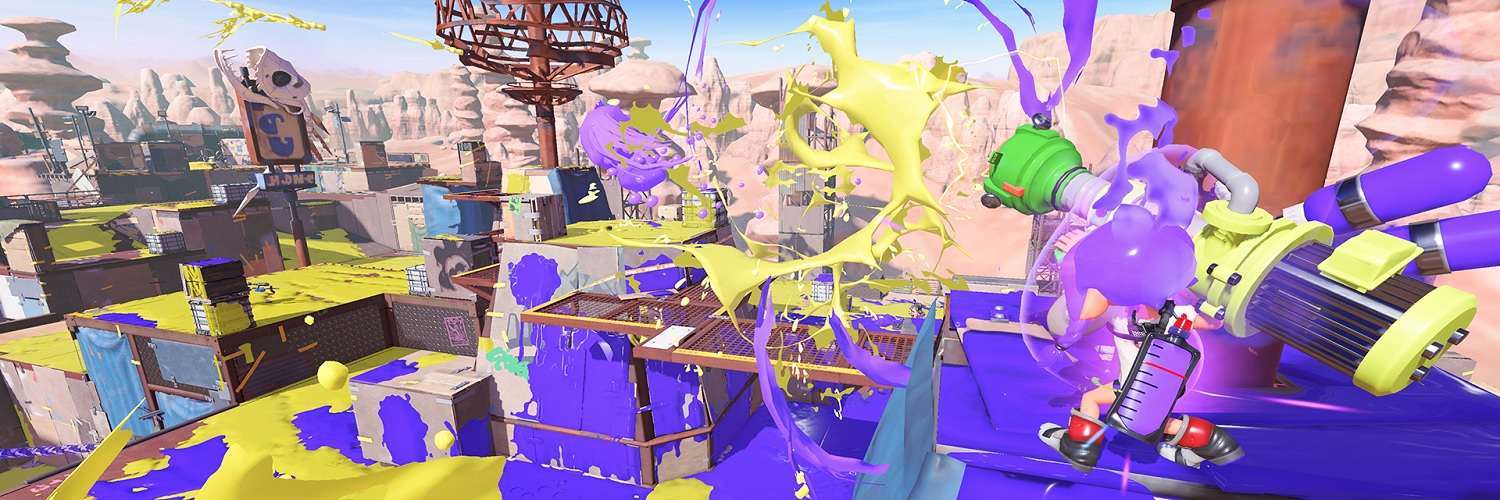
Splatoon 3 Switch Review
There are not many success stories about Nintendo’s Wii U console, because it fell flat on itself and was one of their worst-selling home consoles. One achievement about the Wii U was that Nintendo was never scared to release new intellectual properties (IP) for the system, which is where Splatoon comes in. Releasing in May of 2015, Splatoon became one of Nintendo’s most successful new IPs since Wii Sports, hitting 4.95 million in sales. That is not bad for 1) a new IP, and 2) sold on a system that only sold 13.56 million units. Nintendo did not want to leave the franchise stuck on a dead platform, so it quickly deployed Splatoon 2 just a few months after the launch of the Nintendo Switch. This enabled the series to grow in popularity, hitting double-digit millions, signalling to Nintendo that they had a massive hit on their hand.
I was not expecting to see a follow-up until Nintendo announces their new home system, especially with all the rumours that were appearing around the next generation of Nintendo hardware last year, but that has seemed to have fizzled out. Here we are now with Splatoon 3, still on the Switch, still supplying all the incredibly fun Splatoon action that we have come to enjoy. It’s a refinement of something familiar, but that familiarity was released over five years ago and so Nintendo has decided to return to the ink squirting series to make it the best version yet.
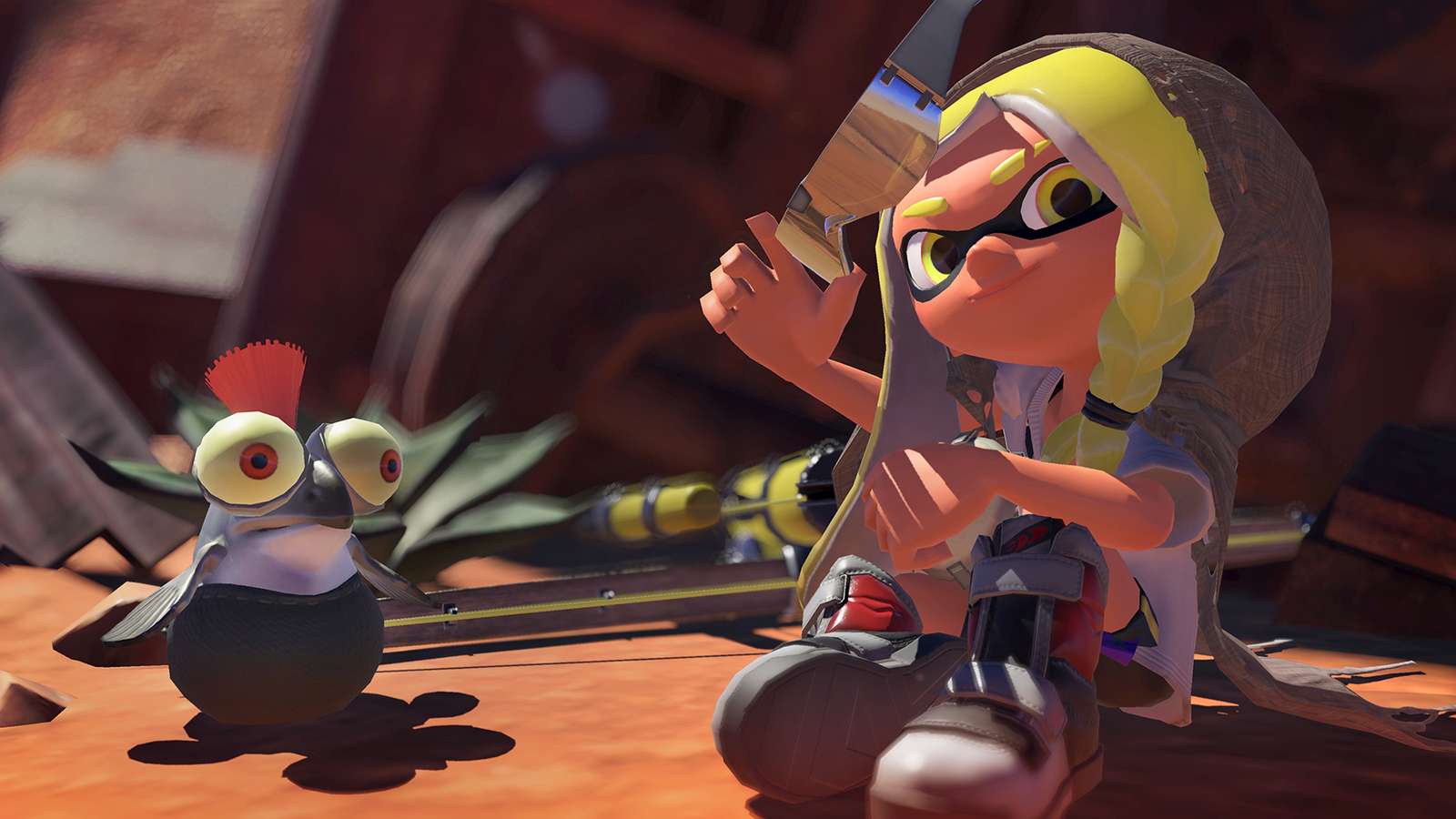
The Splatoon games have always been mainly about getting people to play online. This is Nintendo’s only developed online third-person shooter, or is that ink ‘em up/paint ‘em up/splat ‘em up? Anyway, while the focus is multiplayer, all the games contain single-player content to introduce the player to the game’s mechanics and weapons. Splatoon 3 is no different, bringing another single-player campaign to swim yourself through. This campaign, dubbed Return of the Mammalians, is set in the depths of a volcanic crater that caves in after a fight with DJ Octavio, leading to a snowy-themed zone in which the player must progress across six islands filled with around 70 stages to complete. The player controls Agent 3, their avatar, who has joined the New Squidbeak Splatoon along with his tiny sidekick, Smallfry, who hunts out secrets in the overworld. New Squidbeak Splatoon is a secret group of soldiers who are on a task to find out who has stolen the Great Zapfish this time around since DJ Octavio is denying any involvement.
After the first few tutorial missions, which will be very familiar to fans, it’s not long before the full campaign is open and players are whisked into the real content with the new area, Alterna. Nintendo has taken ideas from Splatoon 2’s Octo Expansion and used that as a blueprint for Splatoon 3’s campaign. It comes with more cutscenes but also a more open approach to finishing the game, as mandatory stages are left to a few later missions in the game and the boss fights.

This is done by focusing on a currency called “Power Eggs”, which are rewarded for finishing missions, collecting them within missions or in the game’s overworld. These power eggs are used to remove the fluffy ooze that has contaminated areas of the overworld, blocking progress to the next island. Removing these with the power eggs enables new areas to visit, which contain new missions to complete, but also hidden collectables, such as decorations to fill up the game’s new locker idea, where players can fill up their lockers with objects and stickers to look fresher than the other players, who will populate your lobby with their lockers once playing online. Completing a mission will always offer a large number of power eggs for a first-time completion bonus, but a lot of the missions have alternative weapons to use, which will offer their own bonus rewards on the same mission. This helps to easily progress through the game, skipping any missions people might find frustrating or too hard.
One thing that has not changed is how people get into these missions, which are unlocked by blasting sealed kettles laying on the surface of the overword. These missions are designed to be bitesize in length, so do not expect a stage to take any longer than five minutes at the most. This is not a negative on the game, as it has enabled the developers to come up with some clever challenges that showcase the brilliant creativity they have. These missions smartly make use of all the game’s weapons and mechanics – who knew how much you could do with inking surfaces and swimming in it.
There is one level where you need to survive jumping over energy beams for 60 seconds, as they speed up and more rings are added. There is a target practice mission that reminds me of clay pigeon shooting, trying to shoot flying boxes in the sky as they launch towards the player. This can be even more challenging when they require multiple weapons to 100% the game, such as trying to use a Slosher on the Splitting Crosshair mission. In this challenge, you are forced to grind on rails, something comparable to Sonic Adventure 2, and try to smash these moveable objects, as doing so extends the rail, but many times I ran out of rail and died, due to the awkwardness of aiming such a weapon. If you beat the story, then expect to have a sort of Champion’s Road from Super Mario 3D World’s final level challenge that will test what you have learnt over the course of the campaign, as this is the franchise’s most difficult mission to overcome. No doubt this is the best single-player content to be featured in the series so far and fans will enjoy what is on offer here before they jump into the wonderful and violent world of online mollusc battling.
But before multiplayer, we need to talk about the Salmon Run, the cooperative horde mode that was added in Splatoon 2. The mode makes a return to Splatoon 3 without any of the silly time limitations that caused it to be unavailable in the predecessor. Salmon Run’s concept remains identical. The player is given a random weapon out of the four that are demonstrated before starting Salmon Run and must use this to survive against the onslaught of salmonids. It comes with the obligatory bonus of adding extra maps, new enemies and new bosses with crazy abilities, which come to cause havoc as the player tries to fill up a net with golden eggs scattered around the map that drop from defeated enemies. There are, of course, new weapons to use to add to the fun.
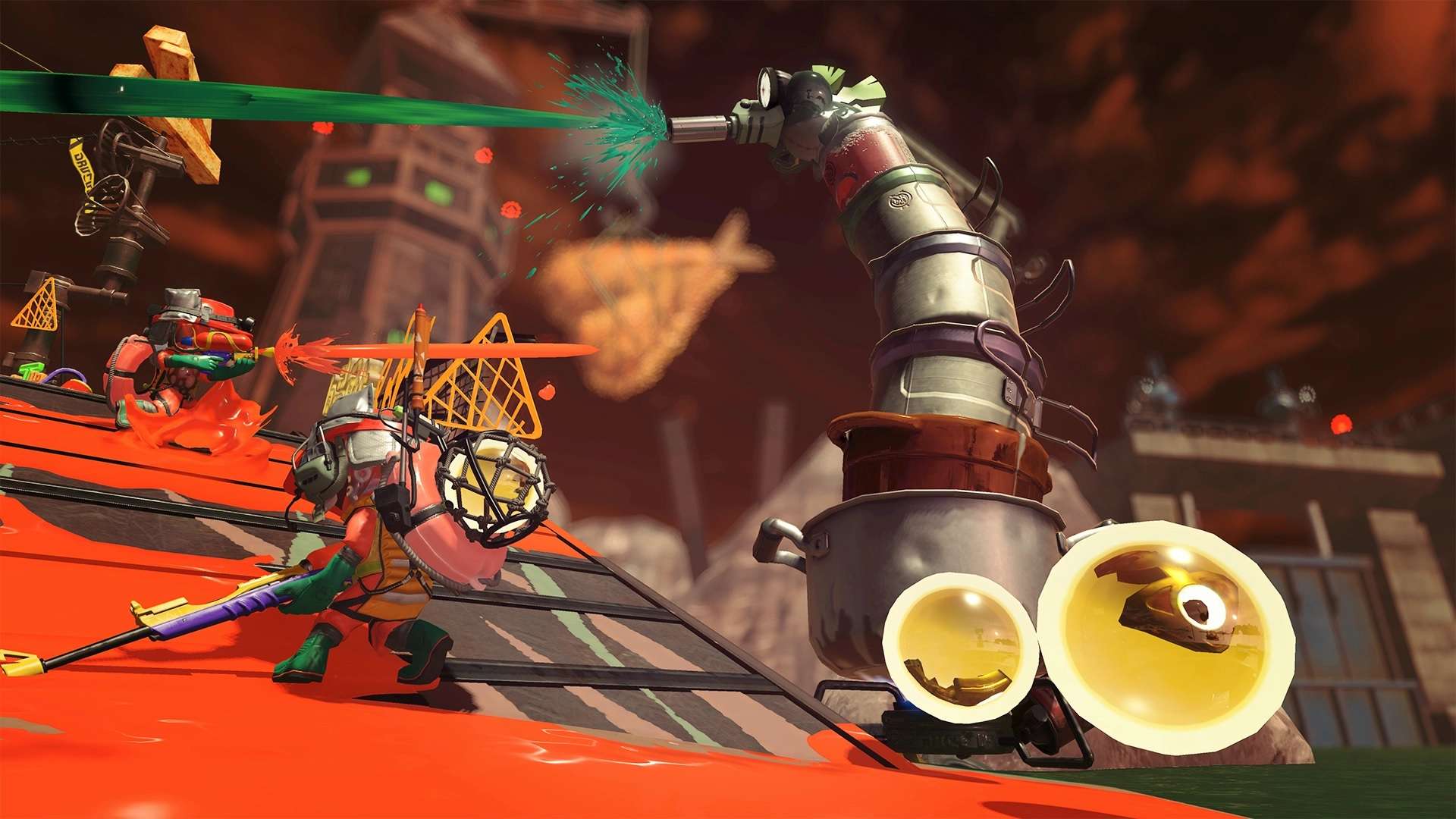
In the grand scheme of things, Salmon Run is the one mode that has had the least improvements to it. I think Nintendo were happy to make it available all the time and have players enjoy what it has to offer, which is an absolute blast, but it can feel stale if constantly played in a single moment. This is due to the maps only rotating daily, along with the random weapons that come with that map selection, which is a shame. There was a mention of new maps and modes coming to Salmon Run in the future, so that is something I am looking forward to seeing, as the mode should be grown because the foundations here are solid to help it become an addictive part of Splatoon 3.
There is one other mode that was thrown in as a distraction from competitive online which sits just to the side of the lobby area for multiplayer. This could easily be missed if it was not for packs of cards that are unlocked during the campaign mode. This new mode is called Tableturf Battler, a versus card game that tries to convert Splatoon’s multiplayer mode, Turf War, into a one vs one card battler. This is done by taking a deck of cards, over 160 in total to collect to build a deck. A deck consists of 15 cards, which are dealt in groups of four on each player’s turn. A card will have an ink placement shape and size that will apply the ink to the board grid (eight different map designs currently exist in this mode). Each player simultaneously plays their card, so they do not know where the opposition is placing theirs, with the idea to cover as much neutral space in their colour as possible. If the cards cross, then the card with the lowest value takes priority and will ink that grid space. The winner is the person with the most ink grids covered on the board. As card games go, it is a rather simple concept, but one that represents Turf War well as a 1 vs 1 card game to enjoy against the CPU at various difficulties. There is an update expected to come that will add multiplayer with real players, so this has the potential to change from something of a distraction to a dangerous time sink if Nintendo plays this right.
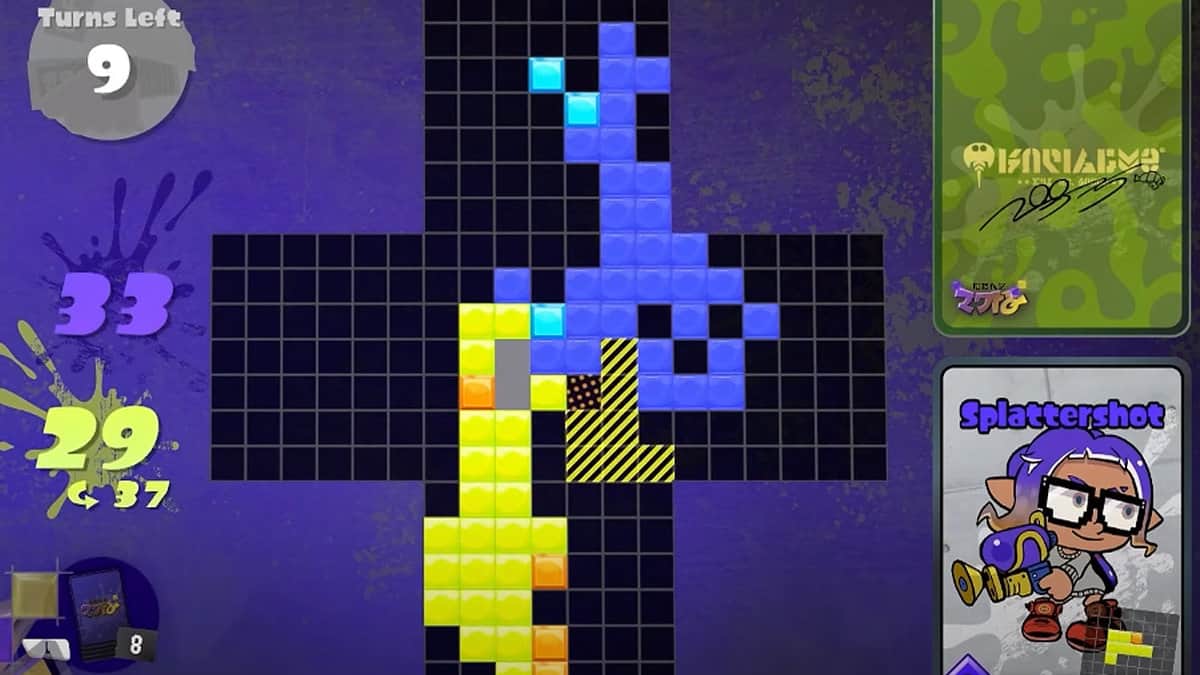
The meat of Splatoon 3, the area that will keep players absorbed for many hundreds of hours, is the game’s multiplayer. The flashy hub world returns, bringing all the other random players who populate it through the servers so that you can check out their profiles, costumes and awesome drawings. This game returns all the good stuff everyone enjoyed about the Splatoon games, but in the grand scheme of things, nothing much has changed when it comes to the modes themselves, it is more so the package that fits around the multiplayer this time, the quality-of-life changes that make the multiplayer less stressful to navigate around – yes, you can now do everything through menus rather than having to walk around to everything! And you can even practice in the lobby hallways while waiting for a match. There are a couple of new moves, such as the wall climbing speed boost and the quick turn that offers invincibility during the air movement, which will separate the pros from the rookies, but nothing too drastic that stands out.
Turf War is once again the main attraction in multiplayer. If you are new to the series, then Turf War is about covering as much ground in your team’s ink colour compared to the opposition, which becomes tense as players begin to colour over the top of the rival team’s ink, as opposition squids swim around to try to take it back. It is a very fast-moving competitive mode that only last three minutes, but due to the 4 vs 4 matchup and the size of the maps, the action never stops, as there is always something to paint or an enemy to take down. It is still super easy to get into matches. Simply go into the lobby, (yes, you can now finally hang in a party with friends in the lobby as you wait for a match to be found, together!), click on the mode and off you go as the game has no issue finding players online and for you to team up with and fight against. It’s this short time in searching and match length that makes it so easy to find yourself playing many matches in a gaming session.

In addition to Turf War is the new Tricolour Turf War, which unlocks during Splatoon’s famous Splatfest events. I managed to get some time with this over the Splatfest that happened during the weekend of the 25th September 2022, so I could add the mode into this review, but it wasn’t easy as it seemed to stick me in matches for Turf War rather than Tricolour on a lot of the occasions, due to lack of players (Note: it seems Nintendo did this on purpose due to some matchmaking issues over the weekend as I found on Twitter before this review went live).
Splatfest special events used to get people to vote a favourite option from two, but in Splatoon 3 there are now three options to pick from. Tricolour Turf War is slightly different, since the maximum player capacity is 8, the game makes these matches a 2 v 2 v 4. This has the 4 in the centre of the map, while the 2 come from either side to try to cover as much of the map as possible, no matter if it is the rival team in the middle or the smaller team on the opposite side; all ground needs to be covered in your team’s ink. To make things more interesting, the team of 4 in the middle are defending the Ultra Signal that if captured by a smaller team will summon the Doom Sprinkler that remains on the map for the rest of the game as it sprays that team’s colour all around it. Tricolour Turf War is a hectic mode that feels unbalanced for the defending team in the middle, as this is more tuned for stupid, chaotic fun between all the teams rather than promoting anything serious for the Splatfest event, which is probably why it is limited to such a time.
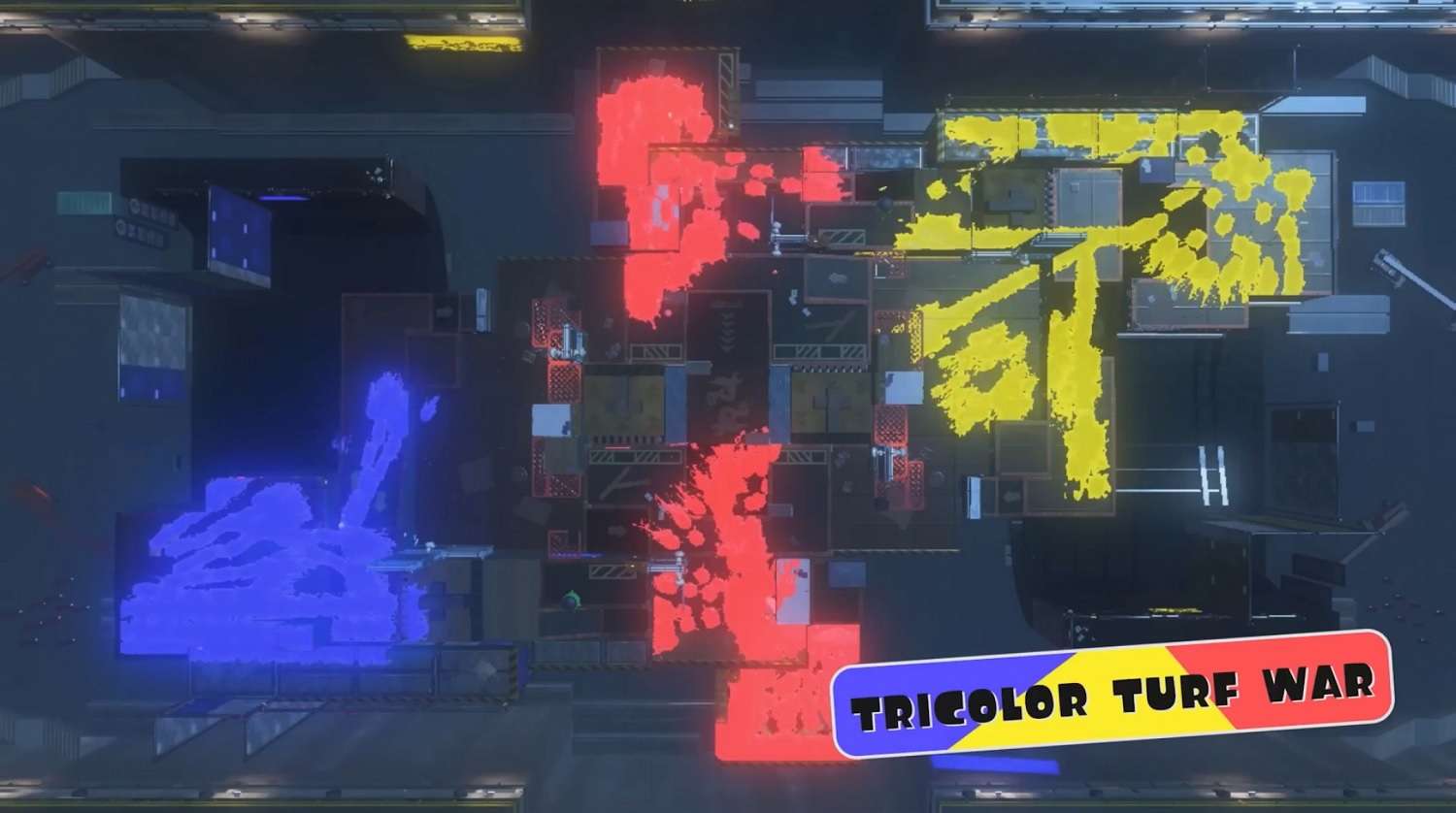
The progression system remains the same as the previous titles, meaning new weapons and gear need to be unlocked as players progress through the level-up system. This can take a lot of hours to do, and people might find that their favourite weapon isn’t unlocked until near the end of level 30, but it makes people try different weapon types to see what sticks. There are a few new weapons and maps added to the game modes. I am enjoying the new tri-stringer crossbow that fires three arrows to splat in a wide arc, or if you hold down the shoot button the bow will charge a power shot that makes them stick to a surface and explode after a short time. Jumping while shooting with the tri-stringer makes them shoot vertically instead of horizontal. In terms of maps, there are five new ones making a total of 12. Of course, more will come, since Nintendo gave free updates to Splatoon 2 for a while, and it seems that this sequel will get even more free support, so that is great news for fans.
While I have a soft spot for returning map Mahi Mahi Resort, the one from the original Splatoon that adjusts the water levels so that the vertically of the map changes towards the end of the match, some of the new maps are just as well designed. Out of those, my favourite is Hagglefish Market, due to its vertically used to get a good view of the map and its small areas of visibility that add a layer of cover play. This makes it a very pop-in and out map of that goes well with the game’s already sneaky swimming ink tactics. There are a lot of great maps here and it should hopefully only get better once the new ones arrive. There is still the 2-hour counter that forces people to play between two maps during that segment, something I am not fond of. I do not see why it cannot just be random or at least add four, so there is a bit more variety during a two-hour session. I guess Nintendo want people to jump into Anarchy Battles as well, with its own map cycle, as this rank mode has four game types, Clam Blitz, Splat Zones, Tower Control, and Rainmaker, all twists on famous versus modes, such as King of the Hill and Capture the Flag.

Even more colourful, engaging and eccentric than ever before, Splatoon 3 is bringing the same highly amusing casual and competitive fun of Splatoon’s unique paint-based versus gameplay and polishes it closer to perfection, like topping up some old decorations with a fresh coat of paint. It is disappointing that there is nothing ground-breaking, as new weapons, maps and a couple of modes are nothing to scream about, but the campaign is the best and most inventive it has been yet, bringing a good solid 7+ hours of fun. The game also throws in a card battler for some added distraction. The quality-of-life improvements to the multiplayer were so needed, bringing the game closer to the current modern age of online gameplay. There are still some of those irksome Nintendo ideas, such as the map rotations locked to two-hour time slots, but with more modes available in one go and a bigger selection of things to do, this feels less annoying than it did in the past. Is it revolutionary? Not at all, but it has been five years since the last game. It feels right for Nintendo to improve on the already great formula to offer its fans the best and most refined take on this refreshing, creative concept yet.
